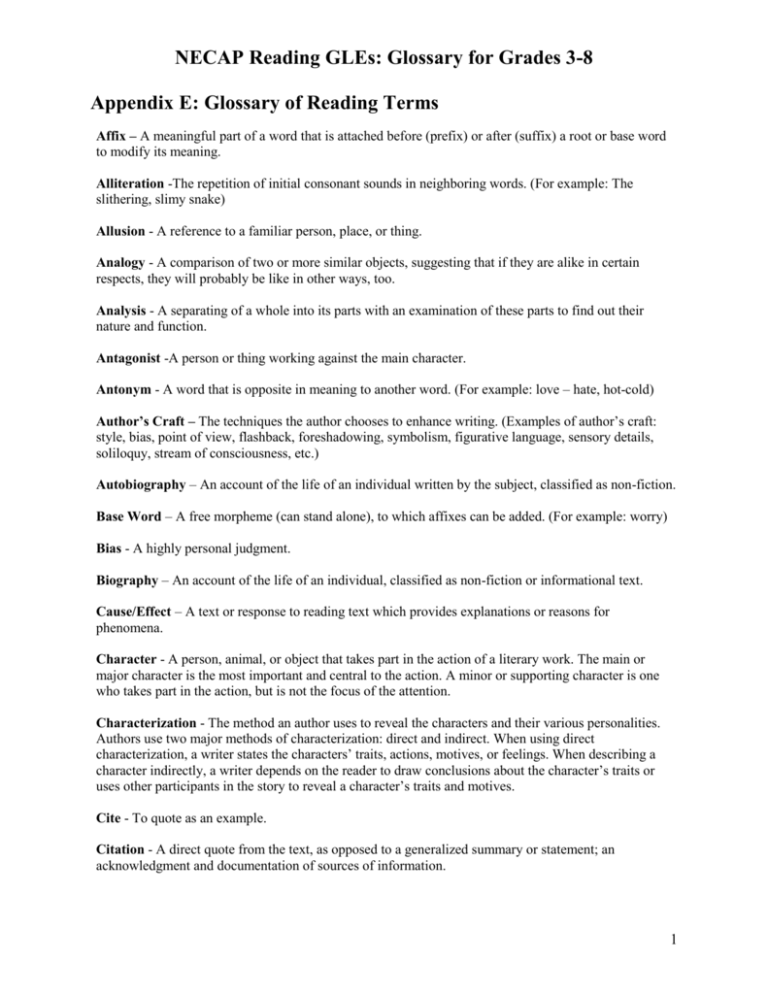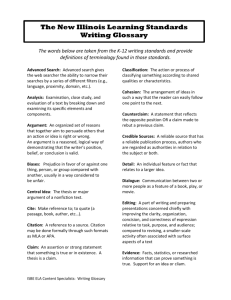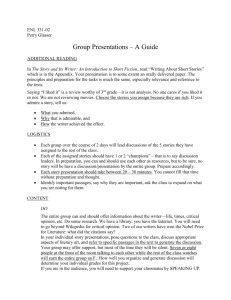Word
advertisement

NECAP Reading GLEs: Glossary for Grades 3-8 Appendix E: Glossary of Reading Terms Affix – A meaningful part of a word that is attached before (prefix) or after (suffix) a root or base word to modify its meaning. Alliteration -The repetition of initial consonant sounds in neighboring words. (For example: The slithering, slimy snake) Allusion - A reference to a familiar person, place, or thing. Analogy - A comparison of two or more similar objects, suggesting that if they are alike in certain respects, they will probably be like in other ways, too. Analysis - A separating of a whole into its parts with an examination of these parts to find out their nature and function. Antagonist -A person or thing working against the main character. Antonym - A word that is opposite in meaning to another word. (For example: love – hate, hot-cold) Author’s Craft – The techniques the author chooses to enhance writing. (Examples of author’s craft: style, bias, point of view, flashback, foreshadowing, symbolism, figurative language, sensory details, soliloquy, stream of consciousness, etc.) Autobiography – An account of the life of an individual written by the subject, classified as non-fiction. Base Word – A free morpheme (can stand alone), to which affixes can be added. (For example: worry) Bias - A highly personal judgment. Biography – An account of the life of an individual, classified as non-fiction or informational text. Cause/Effect – A text or response to reading text which provides explanations or reasons for phenomena. Character - A person, animal, or object that takes part in the action of a literary work. The main or major character is the most important and central to the action. A minor or supporting character is one who takes part in the action, but is not the focus of the attention. Characterization - The method an author uses to reveal the characters and their various personalities. Authors use two major methods of characterization: direct and indirect. When using direct characterization, a writer states the characters’ traits, actions, motives, or feelings. When describing a character indirectly, a writer depends on the reader to draw conclusions about the character’s traits or uses other participants in the story to reveal a character’s traits and motives. Cite - To quote as an example. Citation - A direct quote from the text, as opposed to a generalized summary or statement; an acknowledgment and documentation of sources of information. 1 NECAP Reading GLEs: Glossary for Grades 3-8 Comparison/Contrast - A text or response to reading text that identifies how information presented has similar or different characteristics or qualities. Conflict - The problem or struggle in a story that triggers the action. Conflicts may be internal (struggles from within a character) or external. Context - The set of facts or circumstances surrounding an event or a situation, explanation of characters, or definition of important terms in text; the background information the reader needs to know in order to fully understand the message of the text. Context clues - Information in the reading passage that helps the reader determine the meaning of unfamiliar words or phrases, such as illustrations or the meaning of other words in the text. Controlling Idea – This is the main idea/focus that runs throughout the paper or text. Conventions - Features of standard written English that usually include sentence formation, grammar, spelling, usage, punctuation, and capitalization. Decode – The ability to translate a word from print to speech, usually by employing knowledge of sound-symbol correspondence Dialogue - A conversation between two characters. In poems, novels, and short stories, dialogue is usually set off by quotations marks to indicate a speaker’s exact words; in a play, dialogue follows the names of the characters, and no quotation marks are used. Diction - An author’s choice of words based on their accuracy, clarity, and effectiveness. Drama - A story written to be performed by actors. Dramas are often divided into parts called acts, which are often divided into smaller parts called scenes. Evaluate - Examine and judge carefully, based on evidence found in the text. Figurative Language - Language used in writing or speech that is not meant to be interpreted literally, as the intent of the language is to create a special effect, idea, image, or feeling. Fluency - The clear, easy, written or spoken expression of ideas, or freedom from word-identification problems that may hinder comprehension during silent reading or the expression of ideas during oral reading; The ability to read text accurately, quickly, and with proper expression, phrasing, and intonation between word recognition and comprehension; Rapidly and automatically recognizing and decoding words, with evidence that the reader is accessing the deeper meaning of the text; Assessment of fluency is associated with rate, accuracy, and scores on comprehension tests. Focus - The concentration of a specific idea(s) within the topic the writer is addressing; the main/central idea that runs through a text. (For example: If the topic is “horses,” the focus might be: Horses are very expensive to own.) Genre - A category used to classify literary works, usually by form, technique, or content. For example, literature is commonly divided into three manor genres: poetry, prose, and drama. Each genre is, in turn, divided into sub-genres 2 NECAP Reading GLEs: Glossary for Grades 3-8 Graphic Organizer- A diagram or pictorial device used to record and show relationships among ideas or information. Historical fiction – Fiction drawn from the writer’s imagination, but true to life in some period of the past. Homonym - One of two words that have the same sound and often the same spelling but differ in meaning. (For example, bear “to carry,” bear (the animal), and bare “naked.”) Homophone - One of two or more words that are pronounced the same but differ in meaning, origin, and sometimes spelling. [For example, hair/hare, knight/night, and (fish) scale /(musical) scale.] Hyperbole - A figure of speech in which exaggeration is used for emphasis or effect. Inference - A deduction or conclusion made from facts that are suggested or implied rather than overly stated. (For example: Mom said that I should study more and watch television less. I inferred that I should get better grades or the television would be taken out of my room.) Informational text – A text that provides facts, ideas, and principles that are related to the physical, biological, or social world; classified as non-fiction text. Literary conflict - The tension that grows out of the interplay of the two opposing forces in a plot. Literary devices - Tools used by the author to enliven and provide voice to the writing, such as dialogue, alliteration, foreshadowing, personification, metaphors, etc. Literary elements - The essential techniques used in literature, such as characterization, setting, plot, and theme. Metaphor - A figure of speech in which one thing is described in terms of another to make an implicit comparison – that is, a comparison that does not use words such as “like” or “as.” (For example: The sky’s lamp was bright.) Morpheme – The smallest meaningful unit of language; may be a word or part of a word (For example – “less” or “child”) Narrative - A story, actual or fictional, expressed orally or in writing; a text that tells about a sequence of events. Narrative passage - Text in any form that recounts or tells a story. Narrator - The person (or animal or object) telling a story, who may be a character within the story or someone outside of the story. Onomatopoeia - A figure of speech in which the sound of the word imitates the sounds associated with the objects or actions to which they refer. (For example, crackle, moo, pop, zoom.) Opinion - A belief or conclusion held with confidence, but not sustained with proof. Paraphrase - Restate text or passage mostly in other (or in own) words. 3 NECAP Reading GLEs: Glossary for Grades 3-8 Personification - The attribution of human qualities to inanimate objects. (For example: The clouds played and danced in the sky.) Phoneme - The smallest unit of sound in a spoken word; a speech sound that combines with other sounds in a language to make words. Phonemic awareness ability to hear, identify and manipulate individual sounds in spoken words; Involves blending, segmenting, deleting sounds, etc. Phonics - Relationships between the letters of written language and the individual sounds of spoken language Plot - The plan, design, storyline, or pattern of events in a play, poem, or works of fiction. Poem - A composition characterized by use of condensed language, chosen for its sound and suggestive power and the use of literary techniques such as rhyme, blank verse, rhythm, meter, and metaphor. Point of View - The way in which an author reveals characters, events, and ideas when telling a story; the perspective or vantage point from which a story is told. Problem - The conflict or struggle (internal or external) that causes the action in a story or play. An internal conflict takes place within the mind of a character, such as a struggle to make a decision, take an action, or overcome a feeling. An external conflict is one in which a character struggles against some outside force, such as another person or something in nature. Prose - Writing that is not restricted in rhythm, measure, or rhyme; most writing that is not drama, poetry, or song is considered prose. Protagonist - The main character or hero of a text. Reading critically - Reading in which a questioning attitude, logical analysis, and inference are used to judge the worth of the text; evaluating relevancy and adequacy of what is read; the judgment of validity of worth of what is read, based on sound criteria and evidence. Reading rate - The speed at which a person reads; generally measured as words per minute or words correct per minute. Realistic Fiction – Fiction drawn from the writer’s imagination, but is true to life; often focuses on universal human problems. Resolution - The portion of the play or story in which the problem is resolved. It comes after the climax and falling action and is intended to bring the story to a satisfying end. Rhyme - A metrical device in which sounds at the ends of words or lines or verse correspond. Another common device is the use of internal rhymes, or rhyming words within lines. Rhyme scheme - A regular pattern of rhyming words in a poem, usually indicated by assigning a different letter to each rhyme in a stanza such as, a-b-a-b. Rhythm - In verse or prose, the movement or sense of movement communicated by the arrangement of long and short or stressed and unstressed syllables. 4 NECAP Reading GLEs: Glossary for Grades 3-8 Root – A bound morpheme, usually of Latin origin, that cannot stand alone, but is used to form a family of words with related meanings. (For example: “spec”) Self-monitor - Metacognitive awareness and processes whereby the reader realizes that what is being read is or is not making sense, and adjusts reading strategies to improve comprehension. Semantics - The study of meaning in language, particularly the meaning of words and changes in the meanings. Setting - The time and place of the action in a literary work. The setting includes all the details of a place and time. In most stories, the setting serves as a backdrop or context in which the characters interact and the plot progresses. Simile - A figure of speech in which one thing is likened to another using an explicit comparison (that is, using the words “like” or “as”) to clarify or enhance an image. (For example: It was as cold as an ice cube.) Soliloquy - A speech delivered by a character when he/she is alone on the stage; monologue. Stereotype - A pattern or form that does not change. A character is “stereotyped” if she or he has no individuality and fits the mold of that particular type of person or character, such as a villain. Style - The characteristic manner used by an author to express ideas and create intended effects, including the writer’s use of language, choice of words, and use of literary devices. Summary - Writing that presents the main/central points of a larger work in condensed form. Synonym - Two or more words that have highly similar meanings. (For example: happy, glad, and cheerful.) Syntax - The pattern or structure of word order in sentences, clauses, and phrases. Temporal Sequence – Ideas or events presented in the order in which they happen. Text Structure – The way information is organized and presented. (For example: Fiction texts and biographies generally use a narrative structure and are meant to be read from beginning to end; nonfiction or informational texts are organized by topics or into sections, using text features such as headings, bold print, transitional words/phrases, etc.) Theme - The central idea, message, concern, or purpose in a literary work, which may be stated directly or indirectly. (For example: In the book The Pancake, by Anita Lobel, “People should work together” or “Don’t be too cocky” are themes.) Thesis - The basic proposition put forward by a speaker or writer, which then is proved through fact, argument, or support from a text; the subject or argument of a composition. It is the controlling idea about a topic that the writer is attempting to prove; a sentence that announced the writer’s main, unifying controlling idea about a topic. A thesis statement usually contains two main elements: a limited subject (Internet), a strong verb, and the reason for it - the “why”- (The Internet provides information of varying depth and quality). 5 NECAP Reading GLEs: Glossary for Grades 3-8 Tone - The overall feeling or effect created by a writer’s use of words, sentence structure, and attitude towards the audience, characters, or topic. This feeling, which pervades the work, may be serious, mockserious, humorous, sarcastic, solemn, objective, etc. Traditional literature – Stories passed down orally throughout history. (Examples include: folk tales, fairy tales, myths, legends, and epics.) Turning Point - The moment in a story or a play when there is a definite change in direction and one becomes aware that it is now about to move toward the end. Voice - The style and quality of the writing which includes word choice, a variety of sentence structures, and evidence of investment. Voice portrays the author’s personality or the personality of the chosen persona. It is the fluency, rhythm, and liveliness in writing that makes it unique to the writer. A distinctive voice establishes personal expression and enhances the writing. The following sources were referenced to develop this glossary of reading terms: Fountas and Pinnell (2001) Guiding Readers and Writers Grades 3-6: Teaching Comprehension, Genre, and Literacy. Heinemann Kemper, Sebranek & Meyer (2001) The Write Source. Wilmigton: Houghton Mifflin Moats (2003) LETRS: Language Essentials for Teachers of Reading and Spelling. Sopris West Pennsylvania Department of Education (2003) Reading Assessment Glossary (2001) Put Reading First. National Institute for Literacy, US Department of Education (2004) New England Common Assessment Program Grade Level Expectations for Writing Appendix A: Writing Glossary 6






